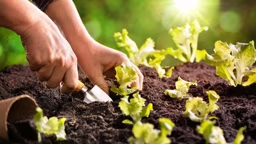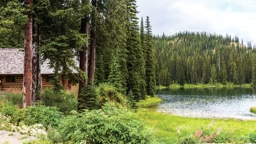Know, then sow
First, list everything you hope to achieve out of your landscape. Talk to experts and read various articles and books to gain as much knowledge as you can about the different aspects you'd like to add to your yard.
First, list everything you hope to achieve out of your landscape. Talk to experts and read various articles and books to gain as much knowledge as you can about the different aspects you'd like to add to your yard.
Share costs with the neighbors
Your dream garden will not appear overnight, so go easy on your self and your wallet by buying things in increments. If your desires still seem attainable, save cash by buying in bulk with your neighbors. And instead of footing the bill for a seldom-used and expensive piece of machinery, rent one with the neighbors. Sharing tools (and the cost) of things like an aerator or a chipper will create wiggle room in your budget.
Your dream garden will not appear overnight, so go easy on your self and your wallet by buying things in increments. If your desires still seem attainable, save cash by buying in bulk with your neighbors. And instead of footing the bill for a seldom-used and expensive piece of machinery, rent one with the neighbors. Sharing tools (and the cost) of things like an aerator or a chipper will create wiggle room in your budget.
The great "xeriscape"
This trend in landscaping (which comes from the Greek word “xeros,” which means “dry”) simply refers to creating a landscape that can withstand drought conditions. As you might have guessed, this saves you money on your water bill, but also provides a landscape which houses durable plants with minimal upkeep.
This trend in landscaping (which comes from the Greek word “xeros,” which means “dry”) simply refers to creating a landscape that can withstand drought conditions. As you might have guessed, this saves you money on your water bill, but also provides a landscape which houses durable plants with minimal upkeep.
Go green
No, it's not just a fad. Adding some green elements to your yard can actually save you money. Consider switching from gas-powered equipment to electric or manual gardening tools that emit less pollution and save you from unwanted “pain at the pump.” And when you water your lawn, do so in the morning when the least amount of water will evaporate, saving both a precious resource and some precious pennies.
No, it's not just a fad. Adding some green elements to your yard can actually save you money. Consider switching from gas-powered equipment to electric or manual gardening tools that emit less pollution and save you from unwanted “pain at the pump.” And when you water your lawn, do so in the morning when the least amount of water will evaporate, saving both a precious resource and some precious pennies.
Compost it
Creating your own compost is an easy and natural way to save money on landscaping costs. Stuffing table scraps in the garbage disposal is literally throwing money down the drain. By saving your orts you can turn your rubbish into fertilizer — saving money on rich soil and fertilizer. There are dozens of compost recipes online, but a simple and effective solution can be found on the Environmental Protection Agency's website. Aside from saving money on soil, you'll be decreasing the amount of waste in landfills and refreshing your garden with a nutrient-filled, natural treat.
Creating your own compost is an easy and natural way to save money on landscaping costs. Stuffing table scraps in the garbage disposal is literally throwing money down the drain. By saving your orts you can turn your rubbish into fertilizer — saving money on rich soil and fertilizer. There are dozens of compost recipes online, but a simple and effective solution can be found on the Environmental Protection Agency's website. Aside from saving money on soil, you'll be decreasing the amount of waste in landfills and refreshing your garden with a nutrient-filled, natural treat.
Bathe with a bucket
If you’re feeling extra frugal, invite a bucket to bathe with you. When filling up the tub — or while you’re showering — collect water racing for the drain with a bucket. If you don’t mind the shower partner you can use this water to serve a thirst-quenching beverage to your outdoor plants. And the same logic can be applied when a glass of water is left sitting around the house destined for the drain. Spare it’s fate by watering thirsty plants with it instead.
If you’re feeling extra frugal, invite a bucket to bathe with you. When filling up the tub — or while you’re showering — collect water racing for the drain with a bucket. If you don’t mind the shower partner you can use this water to serve a thirst-quenching beverage to your outdoor plants. And the same logic can be applied when a glass of water is left sitting around the house destined for the drain. Spare it’s fate by watering thirsty plants with it instead.
Perennial favorites
It may seem obvious, but opting for perennials (plants that grow and flower year after year) can save you a bundle of money. Instead of emptying your piggy bank to restock on seeds every year, pay once upfront and get the gift that keeps on giving. Here is a nearly exhaustive list of perennials.
It may seem obvious, but opting for perennials (plants that grow and flower year after year) can save you a bundle of money. Instead of emptying your piggy bank to restock on seeds every year, pay once upfront and get the gift that keeps on giving. Here is a nearly exhaustive list of perennials.
Dream big, plant small
So you want it made in the shade, but buying mature trees is out of your budget’s reach? Then try purchasing a tree early in it’s life cycle (2-4 years old) instead. What you lose in patience (waiting for it to grow) you’ll make up for in dollars, hundreds of them!
So you want it made in the shade, but buying mature trees is out of your budget’s reach? Then try purchasing a tree early in it’s life cycle (2-4 years old) instead. What you lose in patience (waiting for it to grow) you’ll make up for in dollars, hundreds of them!
Substitute potting
Remember when your childhood imagination could turn a cardboard box into a clubhouse and a few well-placed baseball cards could turn your bicycle into a Harley Davidson? Put that same imagination to use when potting your flowers. Anything from coffee cans to empty fishbowls can house your potted plants. Hit up yard sales and flea markets to find creative containers that can double as artistic-looking homes for your flowers. Also, potted plants offer flexibility in that they can be moved anywhere in your yard and also transferred inside in the event of unexpected frosts.
Remember when your childhood imagination could turn a cardboard box into a clubhouse and a few well-placed baseball cards could turn your bicycle into a Harley Davidson? Put that same imagination to use when potting your flowers. Anything from coffee cans to empty fishbowls can house your potted plants. Hit up yard sales and flea markets to find creative containers that can double as artistic-looking homes for your flowers. Also, potted plants offer flexibility in that they can be moved anywhere in your yard and also transferred inside in the event of unexpected frosts.
Pathways made of sand
Lay your own hardscape by using sand instead of concrete. You'll save money on materials but you can also chip away at the cost of labor. Instead of hiring a professional to build your cement pathway, buy a few bags of sand and place bricks or (even cheaper) find stones to create a stylish and affordable walkway.
Lay your own hardscape by using sand instead of concrete. You'll save money on materials but you can also chip away at the cost of labor. Instead of hiring a professional to build your cement pathway, buy a few bags of sand and place bricks or (even cheaper) find stones to create a stylish and affordable walkway.











